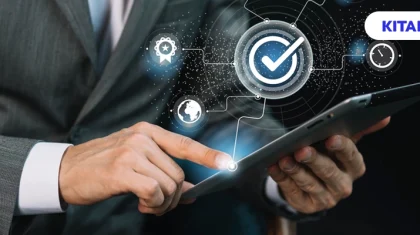
Interactive eLearning: What to Expect in 2024
The intensity of the digital revolution, especially in the learning space, is getting more penetrative by the day. With the market size of the eLearning industry all set to hit a record high of $1 trillion by 2032, it’s safe to say that the future of learning lies online.
But speaking of the future, do you know what’s next in store? So far, we’ve already witnessed some of the most ingenious, remarkable innovations that have escalated the eLearning market to new heights. But is that it? Absolutely not!
As we approach a new era with radical tech inventions, the landscape of digital learning will expand further to become more convenient, synergistic, and inclusive.
So, if you’re an online educator or institution who wants a headstart on this, read this blog. In this post, we will explore the top 7 of the most anticipated interactive eLearning trends and best practices of 2024 and beyond. Let’s dive in!
Table of Contents
I. How Has the eLearning Market Evolved Over the Years?
II. Top 7 Interactive eLearning Trends and Best Practices You Can Expect in 2024
- Artificial Intelligence (AI)
- Gamification
- Augmented Reality (AR) and Virtual Reality (VR)
- Nano Learning
- Virtual Instructor-Led Training (VILT)
- Blended Learning
- Learning Experience Platforms (LXP)
III. Wrapping Up
How Has the eLearning Market Evolved over the Years?
The concept of eLearning first emerged in 1999. But, only in the recent past did the market become the giant that it is today. Here’s a brief decade-to-decade timeline to give you a fair idea of eLearning’s evolution over the years:
- Late 1990s: Developments took place in computer-based training (CBT) systems. As a result, distance learning through audio recordings and videotapes became a possibility, and terms like “virtual learning” came into existence.
- Late 2000s: Smartphones and tablets disrupted the market, giving rise to “mobile learning.” With their arrival, the essence of convenience was added to eLearning.
- Late 2010s: This decade saw the incubation of personalization techniques in eLearning. Various adaptive learning technologies, like the Learning Management System (LMS) and the Intelligent Tutoring System (ITS), picked up pace.
- 2020s: Post-pandemic, eLearning became an acute necessity across the globe. From institutions to private educators, distance learning was adopted by all, giving the market a sweeping growth of 400%!
- 2022 and beyond Although there’s been a dip since the end of COVID-19, the interactive eLearning market still continues to grow at a decent CAGR of 14.3% globally.
Top 7 Interactive eLearning Trends and Best Practices You Can Expect in 2024
In the eLearning space, the upcoming years will revolve around the integration of personal touch and immersive experiences in learning.
Below are the top 7 eLearning trends and best practices that you can expect to see in 2024:
Artificial Intelligence (AI)
In 2024, AI-powered learning platforms can pave the way for education. The core purpose of these platforms would be to foster personalized learning in an efficient manner. AI algorithms will analyze every learner’s unique learning needs, helping educators curate a curriculum that is hyper-targeted and result-oriented.
Moreover, these platforms will also automate the most repetitive, time-consuming tasks for educators, such as grading and attendance tracking, to enable them to focus only on the core elements of their pedagogy.
Gamification
Gamification isn’t a new interactive eLearning element. However, there can be developments in this feature to enhance learning engagement further.
Initially, gamification in eLearning was only limited to incorporating levels, badges, scoreboards, and other basic gaming components to make the learning experience competitive and enthralling. But in the next few years, simulations are likely to be introduced in this arena to create natural game-like scenarios in courses.
KITABOO is a remarkable digital textbook platform that integrates gamification elements to make learning more interactive and enjoyable. It also employs strategies beyond traditional gamification components to enrich the learning experience.
Augmented Reality (AR) and Virtual Reality (VR)
Speaking of gaming, AR and VR solutions have revamped the entire industry to make it more immersive and lifelike. And well, that’s what they’re expected to do in the eLearning sector, too.
In the coming years, educators will be able to create a practical learning environment through AR and VR technologies. With the help of headsets and other hardware devices, it can become possible to conduct realistic field trips and expeditions right from the classroom.
Nano Learning
Nano learning is a fresh concept in the interactive eLearning sector. This basically involves the curation of bite-sized microlearning modules to help learners ingest the entire lesson more effectively.
In this context, the role of mobile learning devices will be prime. As it so happens, the idea behind nano learning isn’t only to make courses easily digestible. It also aims to encourage flexibility and convenience in learning. Thus, content optimized for mobile devices like smartphones and tablets will become prevalent.
Virtual Instructor-Led Training (VILT)
Virtual learning techniques can make a significant comeback in 2024. With the help of Virtual Instructor-Led Training (VILT), institutions will be able to facilitate education for distant students, keeping participation and active involvement intact.
The main USP of this best practice would be to deliver an interactive learning experience through live sessions, video conferences, and so on.
Blended Learning
Blended learning was the most popular in the early 2000s. But you can expect to see a major number of educators retreating to this teaching approach in 2024.
Basically, this practice involves combining both virtual and in-person teaching to impart education in a way that is engaging yet convenient. This way, blended learning eliminates the drawbacks of orthodox online learning and traditional learning to deliver the most fulfilling experience.
Learning Experience Platforms (LXP)
Finally, the Learning Experience Platform (LXP) is another interactive eLearning tool highly anticipated in 2024.
Emerging as an enhanced alternative to a Learning Management System (LMS), LXPs will do much more than just course management. Through their optimization, institutions can seamlessly curate personalized content for their students. Moreover, these platforms will also support gamification elements, making the entire learning experience interactive and customized.
Wrapping Up
When it comes to development, the eLearning sector has come a long way. From being a mere medium for distance education to becoming an interactive means of learning at one’s comfort, interactive eLearning trends and best practices have evolved to address a learner’s changing needs.
The benefits of a well-regarded digital textbook platform like KITABOO can be fully utilized in this context. This application makes it simple for educators and educational institutions to produce creative, dynamic eLearning materials, such as eBooks and digital textbooks.
Connect with us to learn more.
Discover how a mobile-first training platform can help your organization.
Kitaboo is a cloud-based platform to create, deliver & track mobile-first interactive training content.






